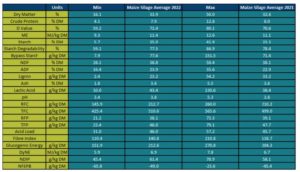Maize Analysis
• Maize silage averages for 2022 are reported in Table 1.
• Dry matter of maize silage is similar in range to what has been reported in previous years ranging from 16 – 50% DM, however this season there are a larger proportion of higher DM samples, meaning the average DM for 2022 maize silage is 33.9%, almost 2% higher than the average DM reported for 2021.
• Crude protein is similar to last season, with NDF approximately 1% higher and lignin analysing approximately 10g/kg DM lower, similar to the 2020 season. Lignin is reported as 23.2g/kg DM vs. 33.2g/kg DM in 2021. Most likely due to the drought and poor looking maize crops that some may end up very lignified, but on average post rain those crops managed to pick up and analyse well.
• Starch content is higher than last season at 35% DM, which is almost 5% greater than the 2020 season. Starch degradability is marginally lower by 1% on average; however, this may change over time in individual silages. Bypass starch is 77.6g/kg DM vs. 71.4g/kg DM last year; this shows that maize silage has the ability to support milk production and improve energy available to the animal from maize silage.
• Due to higher starch levels overall and increased digestibility, fermentable carbohydrates are higher than previous years, therefore acid load is slightly increased. However, this has contributed to increased energy levels along with increased bypass starch levels.

Key points for winter rationing
❖ Increasing starch degradability. Starch degradability increases the more time it the crop is in the clamp leading to increased fermentable carbohydrates in the rumen and increased acid loading, therefore there is an added risk of acidosis. This change is more pronounced over time in drier silages so maize silage must be analysed regularly and monitored to ensure this risk is minimized.
❖ Increased energy availability. Changes in starch degradability improve energy output from rumen fermentation, however starch that is bypass is also more digestible in the small intestine. This means that more energy will be available to the animal so cost savings could be made in the ration by making small tweaks to account for the extra energy in maize silage over time. Make sure you analyze your maize silage regularly.
❖ Increased risk of hindgut acidosis. With increased starch levels and higher bypass starch levels it will be important to ensure rations are not overloading the hindgut with starch. Too much fermentable carbohydrate in the rumen and in the hindgut can lead to multiple sources of acidosis, resulting in leaky gut and poor gut health causing a huge inflammatory response and energy drain on the animal. The result will be loss of yield which can impact on resilience and longevity of the animal.
